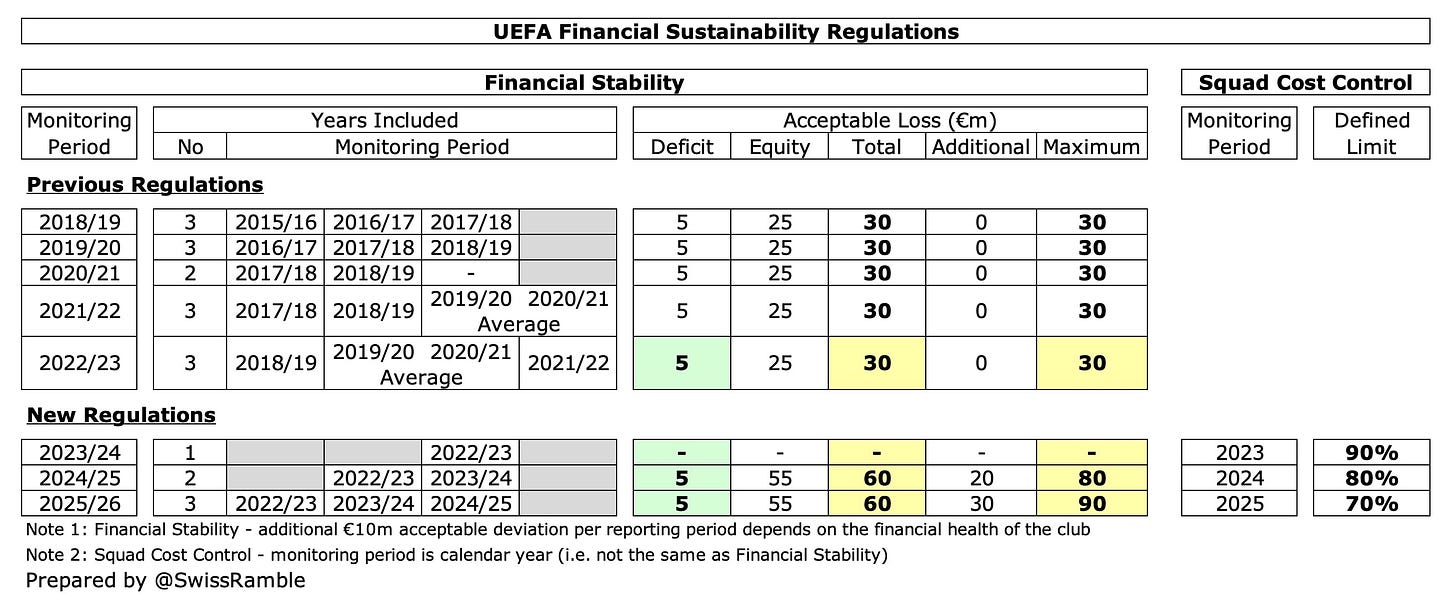Last week I looked at the position of clubs in terms of the Premier League’s Profitability and Sustainability Regulations, but noted that the leading clubs also have to face the challenge of UEFA’s rules.
These are stricter than the Premier League, as allowable losses are smaller, even though these have been increased in the updated guidelines, while clubs also have to contend with the new squad cost control ratio.
So this week we will look at UEFA’s regulations in detail to see whether the seven English clubs that have qualified for Europe are compliant:
Champions League – Manchester City, Arsenal, Liverpool and Aston Villa
Europa League – Tottenham Hotspur and Manchester United
Europa Conference – Chelsea
UEFA Regulations
In 2022 UEFA introduced amended regulations to focus on the financial sustainability of clubs with three key pillars being monitored:
Solvency
Stability
Cost Control
Solvency
Solvency requirements have been addressed by strengthening the rules around overdue payables for football clubs, tax authorities and employees to better protect creditors, including mandatory assessments and quarterly payment dates (15 days to settle overdue amounts).
Stability
Stability is covered by the former Financial Fair Play (FFP) rules, whereby a club’s loss over the 3-year monitoring period is restricted to an “acceptable deviation”.
However, the limit has been doubled from €30m to €60m, so long as any excess over €5m is covered by an equity contribution from the owner.
In addition, if a club is deemed to be in good financial health, then it could be permitted up to an additional €10m allowance per reporting period, i.e. €30m over the 3-year monitoring period.
This would mean that a club’s FFP allowable losses could potentially triple from €30m under the old regime to a maximum of €90m.
There was no UEFA acceptable deviation test to pass for the 2023/24 sporting season, because the counter was set to zero as part of the transition to the new regulations, so clubs did not have to worry about any assessment.
The rationale was that UEFA wanted to make a clean break from the COVID years, so future assessments would not be complicated by having to adjust for the impact of the pandemic.
However, UEFA’s regulations do apply for the 2024/25 monitoring period, though this only covers two years, namely 2022/23 and 2023/24.
It is only from the 2025/26 monitoring period onwards that UEFA will look at the previous three years (i.e. 2022/23, 2023/24 and 2024/25).
Cost Control
The biggest change in the new rules was the introduction of squad cost control with the ratio of player wages, transfers and agent fees ultimately being limited to 70% of revenue plus profit on player sales.
UEFA’s objectives in adding the new cost control ratio were to:
Provide a direct measure between squad costs and income to encourage more performance-related costs.
Limit the inflationary impact of wages and transfer fees of players.
Unlike the Stability and Solvency rules, the Cost Control rule does not have a predecessor in the old FFP regulations. It is true that UEFA had previously recommended keeping wages below 70% of revenue, but a similar ratio has now been formally incorporated in the latest regulations as one of the three formal pillars.
This is interesting, as it is effectively the first time that UEFA has applied a salary cap, albeit a “soft” variant, while the financial sanctions could be described as a sort of “luxury tax”.
Stability Monitoring Period
As we saw earlier, in advance of UEFA competitions next season, we need figures for the 2022/23 and 2023/24 seasons for the stability calculation. We have the actual results for 2022/23, but unfortunately will have to estimate 2023/24, as those accounts will not be published for many months.
Keep reading with a 7-day free trial
Subscribe to The Swiss Ramble to keep reading this post and get 7 days of free access to the full post archives.





